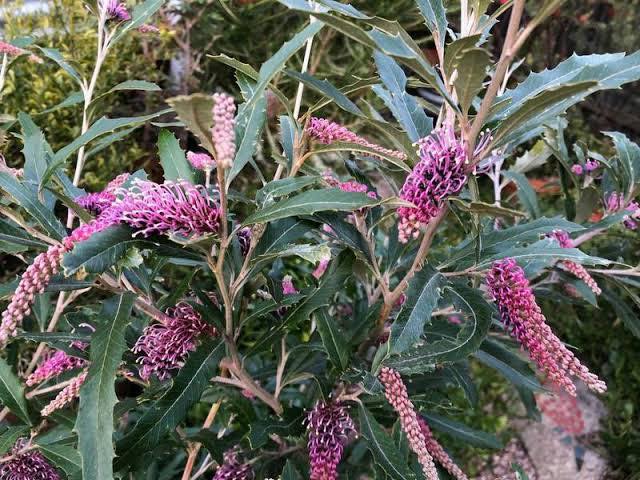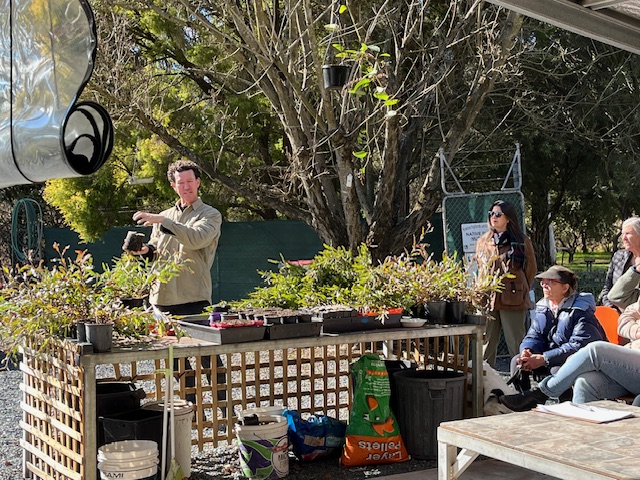
Efforts are being made to ensure the future of the highly endangered Tumut grevillea is secure. Photo: Riverina Highlands Landcare Nursery.
On the undulating, sometimes stony banks of the Goobarragandra River east of Tumut, a striking mauve-flowered shrub has quietly endured for generations.
Known only to this small pocket of country, the Grevillea wilkinsonii – or Tumut grevillea – is one of the most endangered plants in NSW.
But in July, a large number of people joined two hands-on propagation workshops to help secure its future.
Held at the Riverina Highlands Landcare Nursery near Tumut, the Rare Plant Propagation Workshops gave community members – including schoolchildren, local gardeners and landholders – the opportunity to learn how to grow the Tumut grevillea from seed and cuttings.
The sessions were led by Dr David Hunter, Senior Threatened Species Officer with the NSW Department of Climate Change, Energy, the Environment and Water (DCCEEW), and were part of the broader Refreshing Rivers Project, funded by the NSW Environmental Trust.
Organisers say increasing public awareness and community propagation can play a vital role in preventing the plant from vanishing altogether.
The shrub was first noted in the early 1980s by Tumut naturalist Tom Wilkinson who reportedly spotted the unfamiliar plant as he was fishing along the Goobarragandra River.
His discovery led to the formal scientific description of the species a decade later, and in 1993 botanists named it Grevillea wilkinsonii in his honour.
The plant grows up to two metres tall and wide, with long, toothed leaves and vibrant purple “toothbrush”-style flowers that bloom in winter and spring.
It prefers riparian habitats and remains confined to a narrow 6 km stretch of river, with a second, much smaller population near Gundagai.

Senior threatened species officer with the NSW Department of Climate Change, Energy, the Environment and Water, Dr David Hunter led the two workshops near Tumut. Photo: Cherie White, LLS
But by the time it was formally described and named in Wilkinson’s honour in 1993, fewer than 1000 plants remained in the wild – having been reduced by a combination of environmental and human-induced threats – including grazing, weed invasion, flooding and habitat fragmentation.
The discovery not only added a new species to the botanical record but also sounded the alarm on how close it had come to disappearing unnoticed.
A formal national recovery plan for Grevillea wilkinsonii was adopted in 2001, following nearly a decade of groundwork by a dedicated recovery team.
Led by the NPWS alongside botanists, landholders and the Australian National Botanic Gardens, the plan identified key threats and set out a long-term strategy to protect remaining populations.
Actions included fencing habitat, propagating plants in nurseries, storing seed and involving local communities in conservation efforts.
That early work laid the foundation for the restoration projects now underway through programs like Refreshing Rivers.
The July workshops built on these efforts by involving the broader community in a practical and accessible way.
Seed used during the sessions was collected earlier in the season by women from the Brungle Tumut Local Aboriginal Land Council, as part of a collaborative seed-collecting initiative.
Over five days, they gathered a range of native seeds – including grevilleas, acacias and native grasses – from public lands and traditional sites.
These seeds are now being used in revegetation work, contributing to both ecological recovery and cultural renewal.
Riverina Local Land Services (LLS) reported strong interest in the two workshops, with 46 total participants, many from the Snowy Valleys, but others travelling from across the wider Riverina region.
While the Tumut grevillea may be rare in the wild, it has proven hardy when grown in the right conditions.
The Riverina Highlands Landcare Nursery continues to propagate the plant as part of its ongoing conservation efforts, ensuring the species is not only preserved but also made available to the broader community.
Gardeners who have cultivated the plant at home say it flowers well, attracts birds and bees and can occasionally self-seed under suitable conditions.
As native plant restoration continues across the region, community-led efforts like the propagation workshops are seen as an essential part of the recovery strategy – not just to boost numbers, but to foster long-term custodianship.
The fate of the Tumut grevillea now rests, in part, with those who have taken it home.







